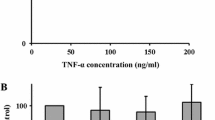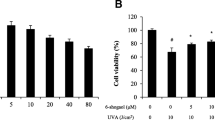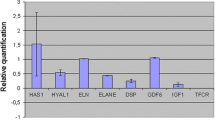Abstract
Skin aging is a complex biological process induced by intrinsic and extrinsic factors which is characterized by clinical and cellular changes, especially dermal fibroblasts. It is possible that, some procedures, such as low-level laser therapy (LLLT), could decelerate this process. To test this hypothesis, this study evaluated the in vitro LLLT on dermal fibroblast cell line (HFF-1) with premature senescence H2O2-induced. HFF-1 cells were cultured in standardized conditions, and initially H2O2 exposed at different concentrations. Fibroblasts were also just exposed at different LLLT (660 nm) doses. From these curves, the lowest H2O2 concentration that induced indicators of premature senescence and the lowest LLLT doses that triggered fibroblast proliferation were used in all assays. Cellular mortality, proliferation, and the levels of oxidative, inflammatory cytokines, apoptotic markers, and of two growth signaling molecules (FGF-1 and KGF) were compared among treatments. The H2O2 at 50 μM concentration induced some fibroblast senescence markers and for LLLT, the best dose for treatment was 4 J (p < 0.001). The interaction between H2O2 at 50 μM and LLLT at 4 J showed partially reversion of the higher levels of DNA oxidation, CASP 3, CASP 8, IL-1B, IL-6, and INFy induced by H2O2 exposure. LLLT also trigger increase of IL-10 anti-inflammatory cytokine, FGF-1 and KGF levels. Cellular proliferation was also improved when fibroblasts treated with H2O2 were exposed to LLLT (p < 0.001). These results suggest that in fibroblast with some senescence characteristics H2O2-induced, the LLLT presented an important protective and proliferative action, reverting partially or totally negative effects triggering by H2O2.





Similar content being viewed by others
Change history
30 November 2023
A Correction to this paper has been published: https://doi.org/10.1007/s10103-023-03943-7
References
Lephart ED (2016) Skin aging and oxidative stress: Equol’s anti-aging effects via biochemical and molecular mechanisms. Ageing Res Rev 31:36–54
Cole MA, Quan T, Voorhees JJ, Fisher GJ (2018) Extracellular matrix regulation of fibroblast function: redefining our perspective on skin aging. J Cell Commun Signal 12:35–43
Birch-Machin MA, Bowman A (2016) Oxidative stress and ageing. Br J Dermatol 175:26–29
Silva SAME, Michniak-Kohn B, Leonardi GR (2017) An overview about oxidation in clinical practice of skin aging. An Bras Dermatol 92:367–374
Zachary CB (2016) Facial rejuvenation: 40th anniversary review. Semin Cutan Med Surg 35:122–124
Ramos FS, Maifrino LBM, Alves da Costa Aguiar S, Perez MM, Feder D, Azzalis LA et al (2018) The effects of transcutaneous low-level laser therapy on the skin healing process: an experimental model. Lasers Med Sci 33:967–976
McFarland GA, Holliday R (1999) Further evidence for the rejuvenating effects of the dipeptide L-carnosine on culture human diploid fibroblasts. Exp Gerontol 34:35–45
Merrell JG, McLaughlin SW, Tie L, Laurencin CT, Chen AF, Nair LS (2009) Curcumin-loaded poly(epsilon-caprolactone) nanofibres: diabetic wound dressing with anti-oxidant and anti-inflammatory properties. Clin Exp Pharmacol Physiol 36:1149–1156
Delgado L, Fernandes I, Gonzaléz-Manzano S, de Freitas V, Mateus N, Santos-Buelga C (2014) Anti-proliferative effects of quercetin and catechin metabolites. Food Funct 5:797–803
Zdanov S, Remacle J, Toussaint O (2006) Establishment of H2O2-induced premature senescence in human fibroblastsconcomitant with increased cellular production of H2O2. Ann N Y Acad Sci. 1067:210–216
Cirillo N, Vicidomini A, McCullough M, Gambardella A, Hassona Y, Prime SS et al (2015) A hyaluronic acid-based compound inhibits fibroblast senescence induced by oxidative stress in vitro and prevents oral mucositis in vivo. J Cell Physiol 230:1421–1429
Barbisan F, Azzolin VF, Ribeiro EE, Duarte MMMF, da Cruz IBM (2017) The in vitro influence of a genetic superoxide-hydrogen peroxide imbalance on immunosenescence. Rejuvenation Res 20:334–345
Costa F, Barbisan F, Assmann CE, Araújo NKF, de Oliveira AR, Signori JP et al (2017) Seminal cell-free DNA levels measured by picogreen fluorochrome are associated with sperm fertility criteria. Zygote 25:111–119
Azzolin VF, Cadoná FC, Machado AK, Berto MD, Barbisan F, Dornelles EB et al (2016) Superoxide-hydrogen peroxide imbalance interferes with colorectal cancer cells viability, proliferation and oxaliplatin response. Toxicol in Vitro 32:8–15
Toussaint O, Medrano EE, von Zglinicki T (2000) Cellular and molecular mechanisms of stress-induced premature senescence (SIPS) of human diploid fibroblasts and melanocytes. Exp Gerontol 35:927–945
Marthandan S, Menzel U, Priebe S, Groth M, Guthke R, Platzer M (2016) Conserved genes and pathways in primary human fibroblast strains undergoing replicative and radiation induced senescence. Biol Res 49:34
Ortiz-Espín A, Morel E, Juarranz Á, Guerrero A, González S, Jiménez A et al (2017) An extract from the plant Deschampsia antarctica protects fibroblasts from senescence induced by hydrogen peroxide. Oxidative Med Cell Longev 2017:2694945
Kuilman TC, Michaloglou C, Mooi WJ, Peeper DS (2010) The essence of senescence. Genes Dev 24:2463–2479
Campisi J (2011) Cellular senescence: putting the paradoxes in perspective. Curr Opin Genet Dev 21:107–112
Turner JD, Naylor AJ, Buckley C, Filer A, Tak PP (2018) Fibroblasts and osteoblasts in inflammation and bone damage. Adv Exp Med Biol 1060:37–54
Yun IG, Ahn SH, Yoon WJ, Kim CS, Lim YK, Kook JK (2018) Litsea japonica leaf extract suppresses Proinflammatory cytokine production in periodontal ligament fibroblasts stimulated with Oral pathogenic bacteria or interleukin-1β. Int J Mol Sci 23(19)
Shirato K, Koda T, Takanari J, Sakurai T, Ogasawara J, Imaizumi K et al (2018) Anti-inflammatory effect of ETAS®50 by inhibiting nuclear factor-κβ p65 nuclear import in ultraviolet-B-irradiated normal human dermal fibroblasts. Evid Based Complement Alternat Med 2018:5072986
Verma A, Stellacci F (2010) Effect of surface on nanoparticle-cell interactions. Small 6:12–21
Bayat M, Virdi A, Jalalifirouzkouhi R, Rezaei F (2018) Comparison of effects of LLLT and LIPUS on fracture healing in animal models and patients: a systematic review. Prog Biophys Mol Biol 132:3–22
Migliario M, Sabbatini M, Mortellaro C, Renò F (2018) Near infrared low level laser therapy and cell proliferation: the emerging role of redox sensitive signal transduction pathways. J Biophotonics 11(11):e201800025
Yan J, Wang J, Huang H, Huang Y, Mi T, Zhang C et al (2017) Fibroblast growth factor 21 delayed endothelial replicative senescence and protected cells from H2O2-induced premature senescence through SIRT1. Am J Transl Res 9:4492–4501
Devi S, Kumar N, Kapila S, Mada SB, Reddi S, Vij R et al (2017) Buffalo casein derived peptide can alleviates H2O2 induced cellular damage and necrosis in fibroblast cells. Exp Toxicol Pathol 69:485–495
Huang C, Qian SL, Sun LY, Cheng B (2016) Light-emitting diode irradiation (640 nm) regulates keratinocyte migration and cytoskeletal reorganization via hypoxia-inducible factor-1α. Photomed Laser Surg 34:313–320
Szezerbaty SKF, de Oliveira RF, Pires-Oliveira DAA, Soares CP, Sartori D, Poli-Frederico RC (2018) The effect of low-level laser therapy (660 nm) on the gene expression involved in tissue repair. Lasers Med Sci 33:315–321
Silveira PC, Scheffer Dda L, Glaser V, Remor AP, Pinho RA, Aguiar Junior AS, Latini A (2016) Low-level laser therapy attenuates the acute inflammatory response induced by muscle traumatic injury. Free Radic Res 50:503–513
Da Ré Guerra F, Vieira CP, Oliveira LP, Marques PP, dos Santos Almeida M, Pimentel ER (2016) Low-level laser therapy modulates pro-inflammatory cytokines after partial tenotomy. Lasers Med Sci 31:759–766
Żerańska J, Pasikowska M, Szczepanik B, Mlosek K, Malinowska S, Dębowska RM et al (2016) A study of the activity and effectiveness of recombinant fibroblast growth factor (Q40P/S47I/H93G rFGF-1) in anti-aging treatment. Postepy Dermatol Alergol 33:28–36
Denadai AS, Aydos RD, Silva IS, Olmedo L, de Senna Cardoso BM, da Silva BAK et al (2017) Acute effects of low-level laser therapy (660 nm) on oxidative stress levels in diabetic rats with skin wounds. J Exp Ther Oncol 11:85–89
Pansani TN, Basso FG, Turrioni AP, Soares DG, Hebling J, de Souza Costa CA (2017) Effects of low-level laser therapy and epidermal growth factor on the activities of gingival fibroblasts obtained from young or elderly individuals. Lasers Med Sci 32:45–52
Canady J, Arndt S, Karrer S, Bosserhoff AK (2013) Increased KGF expression promotes fibroblast activation in a double paracrine manner resulting in cutaneous fibrosis. J Invest Dermatol 133:647–657
Migliario M, Pittarella P, Fanuli M, Rizzi M, Renò F (2014) Laser-induced osteoblast proliferation is mediated by ROS production. Lasers Med Sci 29:1463–1467
Kreslavski VD, Fomina IR, Carpentier DALR, Kuznetsov VV, Allakhverdiev SI (2012) Red and near infra-red signaling: hypothesis and perspectives. J Photochem Photobiol C: Photochem Rev 13:190–203
Rathnakar B, Rao BSS, Prabhu V, Chandra S, Mahato KK (2018) Laser-induced autofluorescence-based objective evaluation of burn tissue repair in mice. Lasers Med Sci 33(4):699–707
Author information
Authors and Affiliations
Corresponding author
Ethics declarations
Conflict of interest
The authors declare that they have no conflict of interest.
Ethics approval
Since the study used commercial cell lines, it is not necessary to submit to an ethics committee.
Additional information
Publisher’s note
Springer Nature remains neutral with regard to jurisdictional claims in published maps and institutional affiliations.
The original version of this article was revised: This article was originally published with an incorrect author name: Moisés Henrique Mastela. The correct information for the author's name is Moisés Henrique Mastella.
Rights and permissions
Springer Nature or its licensor (e.g. a society or other partner) holds exclusive rights to this article under a publishing agreement with the author(s) or other rightsholder(s); author self-archiving of the accepted manuscript version of this article is solely governed by the terms of such publishing agreement and applicable law.
About this article
Cite this article
Maldaner, D.R., Azzolin, V.F., Barbisan, F. et al. In vitro effect of low-level laser therapy on the proliferative, apoptosis modulation, and oxi-inflammatory markers of premature-senescent hydrogen peroxide-induced dermal fibroblasts. Lasers Med Sci 34, 1333–1343 (2019). https://doi.org/10.1007/s10103-019-02728-1
Received:
Accepted:
Published:
Issue Date:
DOI: https://doi.org/10.1007/s10103-019-02728-1




